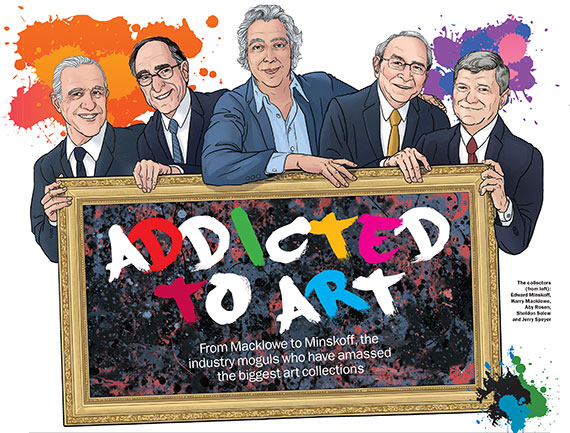
Whenever Edward Minskoff sees the iconic image of a leather-clad Marlon Brando on a motorcycle, he thinks of the one that got away.
Minskoff offered nearly $1 million in the late 1990s for Andy Warhol’s 1966 silkscreen, “Marlon,” which is based on a still from the biker film “The Wild One.” He was stunned when his offer wasn’t accepted. Minskoff claims that the art dealer misrepresented the situation and was actually not authorized to sell the painting.
The developer has good reason to still be crestfallen.
The silkscreen was last sold at a Christie’s New York auction in 2012 for $23.7 million, while another version, “Four Marlons,” went for $69.6 million in November.
“I only felt bad about one piece I lost,” Minskoff said, referring to “Marlon.” “Then again, if you don’t have it, you can’t miss it.”
Minskoff is, of course, not the only New York City real estate mogul with an impressive art collection to go along with his real estate portfolio. Real estate and high-end art tend to go hand-in-hand, both as asset classes and parallel passions.
Judd Tully, art critic and editor-at-large at the international art news website Blouin Artinfo, said real estate executives are often drawn to art collecting. He said in addition to art appreciation, there are two key reasons for that: The wheeling and dealing it takes to secure a coveted piece of art, a process which directly parallels their real estate exploits, and the prestige.
“Whatever the particular occupation may be, the collector becomes something of an addict,” Tully said.
The global pool of contemporary art collectors has grown in recent years from Americans and Europeans to collectors from China, Russia and the Middle East and the “newly minted billionaires of Indonesia and Malaysia,” Tully said.

This giant bronze rat was on display at Aby Rosen’s Lever House until a few months ago.
And like the New York City real estate market, the art market is also on the upswing. As a result, some collectors, like some real estate investors, are wary about buying now because of what they perceive as frothiness in the market.
Despite the expanded pool of ultra-wealthy buyers, “almost all are on the same track of competing for trophy works” like Picasso and Warhol and other brand names, Tully said.
“Most people who own a lot of art use it as its own fund,” said Marion Maneker, publisher of the Art Market Monitor blog, which covers trends in the global art market.” The pieces that appreciate in value — they’ll sell them to buy more art,” Maneker said.
The value of private art collections is hard to pin down. Maneker said that given the high proportion of private sales, calculating the total value of a vast collection is almost impossible.
But there are a slew of real estate moguls — from Related Companies’ Stephen Ross to Cohen Brothers’ Charles Cohen to HFZ Capital’s Ziel Feldman — who collect.
This month, The Real Deal took a close look at some of the moguls with the most notable art collections — those who have been entrenched in the art world for years and have a traceable history. Many raise their paddles at art-house auctions, employ art consultants to help curate their collections and hold board seats at esteemed art institutions.
Harry Macklowe
Developer Harry Macklowe’s wife, Linda Macklowe, is considered the brains behind one of the most valuable private art collections in the industry. Over their 56-year marriage, the couple has amassed a vast collection of postwar and contemporary art.
The value of that collection, however, is anyone’s guess. In her recently released book “The Liar’s Ball,” author Vicky Ward valued it at “around $1 billion.”
A source tied to the art community, however, disputed that figure, saying Ward “pulled that number out of her ass.”
In response, Ward told TRD, “It is around that, per art experts who know it and dealers who helped amass it.”
The Macklowes, whose firm Macklowe Properties is currently building one of the swankiest condominiums in the city at 432 Park Avenue, declined to comment for this story.
Their collection includes works by Franz Kline, Mark Rothko and Gerhard Richter, the book said.
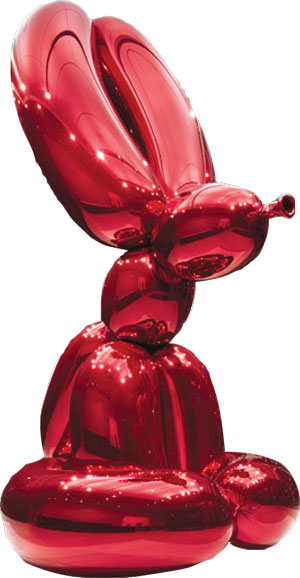
Jeff Koons’ “Balloon Rabbit (Red)” on display at 51 Astor Place.
“The Macklowes are definitely on top of the market,” Tully told TRD. “They attend art fairs and galleries to check out postwar, abstract and expressionist art.”
Linda, a member of the Guggenheim’s Board of Trustees, is said to be “obsessed” with collecting art, while her husband derives joy from outbidding someone at an auction.
“Harry loves [bidding at auction] for the theater, for the social aspects, ’cause everybody’s there. And he likes to be seen out,” an art adviser was quoted as saying in “The Liar’s Ball.”
But Linda has help in her quest for tracking down coveted pieces of art in the form of art dealer and consultant Andrew Fabricant, a partner at the Richard Gray Gallery on Madison Avenue. Fabricant declined to comment when contacted by TRD, but sources described him as “hilarious” and quick to use “sardonic barbs.”
Meanwhile, an assistant helps Linda hang the artwork at their East Hampton home, which is on Georgica Pond, and at their other homes, in a minimalist way, according to “The Liar’s Ball.”
Macklowe’s office is known for displaying art in that same clean style.
Macklowe’s real estate career has famously been marked by significant ups and downs — including the loss of his prized GM Building. His art collecting appears to be a bit volatile as well.
The Macklowes regularly appeared on magazine ARTnews’ list of the world’s 200 most active collectors for most of the 2000s, but have not made the cut since 2010.
And art collection runs in the family. Harry’s brother Lloyd runs the Macklowe Gallery, a Madison Avenue collection of French art nouveau furniture and other antiques. Among the items on sale is a Tiffany lamp valued at more than $500,000, according to the Wall Street Journal.
Sheldon Solow
“There is a wide range of real estate mavens, but at the top of the heap would be Sheldon Solow,” Tully said. Of the group that TRD focused on, Solow has perhaps the most important collection of postwar modern art, Tully added.
He also noted that Solow is known as a “buy-and-hold type of guy.”
At least he was. In recent years, Solow has been more known for selling art than buying it.
Despite the 86-year-old developer’s estimated net worth of $3.6 billion, Solow reportedly sheds portions of his sizable collection of modern and renaissance art to finance real estate and pay off debts.
Solow scooped up much of his collection decades ago, for under $1 million per piece. But those pieces have reportedly appreciated exponentially over time.
For example, he paid a mere $230,000 in 1970 to buy the famed bronze Alberto Giacometti sculpture known as “The Pointing Man,” Tully said.
In May he sold it to SAC Capital Advisors’ Steven Cohen for $141 million at a Christie’s New York auction, according to news reports.
The sculpture, along with a Picasso painting being sold by an unidentified owner, set a unique record in the art world: It was the first time two pieces with an estimated value of $120 million a pop went up for sale at the same auction. It also set an auction price record for a sculpture.
In addition to the $141 million Giacometti, the billionaire has also unloaded $132 million worth of other paintings and sculptures in the last few years by famed names like Amedeo Modigliani, Francis Bacon, Joan Miró and Henry Moore.
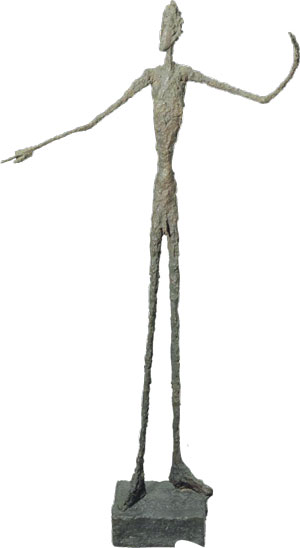
Alberto Giacometti’s “Pointing Man”
His collection still includes works by Henri Matisse, Franz Kline and Balthus.
Solow, more than just about anyone, has also been a pioneer in New York when it comes to using art in his buildings.
The 50-story Solow Building at 9 West 57th Street, which dates back to the 1970s and was his first office project, houses a ground-floor private gallery space for his personal collection.
The Solow Art & Architecture Foundation, a nonprofit he founded in 1991, fills the gallery with art that does not fit in Solow’s office or in one of his several homes.
Meanwhile, Solow’s wife, Mia Fonssagrives-Solow — stepdaughter of famed photographer Irving Penn — is a sculptor who in the spring had a solo exhibition at the Kasher|Potamkin gallery on West 26th Street featuring bronze and aluminum figures shaped like robots and aliens.
Aby Rosen
While most developers keep their relationship with art under wraps, Aby Rosen takes the opposite tack with his massive collection of contemporary art and photography.
The RFR Holding chief personally owns more than 900 pieces of art, including roughly 100 by Warhol. Rosen’s art assemblage, which also includes works by Damien Hirst, Jean-Michel Basquiat and Alexander Calder, has steadily grown over 15 years. Incidentally, his assemblage of buildings in New York and elsewhere has also grown during that time and now includes roughly $10 billion worth of properties globally, including the Seagram Building on Park Avenue and the under-construction 61-story condo tower at 100 East 53rd Street.
The avid Instagrammer — he has nearly 5,000 followers — recently shared a photo of the giant cast aluminum sculpture by artist Urs Fischer known as “Big Clay #4,” which was installed in the plaza in front of the Seagram Building in May and is on display through September. Other works by Fischer have also graced the plaza such as a 20-ton bear sculpture painted a yellow bronze known as “Lamp/Bear.” That sculpture sold for nearly $7 million at a Christie’s auction in 2011.
The German developer — whose mother and father survived the Holocaust and then became a painter and real estate developer respectively — has a penchant for making big statements with his art. He turned the lobby of the Lever House on Park Avenue, for example, into a full-on exhibition space for art, at least some of which he owns. Over the years, the space has been home to art from big names such as Jeff Koons and Calder.
“With Aby Rosen, you see him using art to polish the value of his properties and to enhance the brand,” said Tully, who refers to him as the “czar of art acquisitions” among his real estate colleagues.
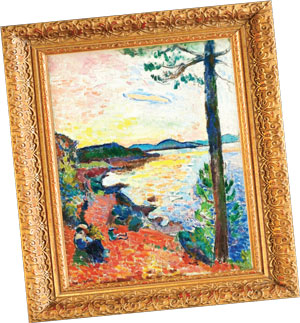
A Matisse painting that’s part of Sheldon Solow’s collection.
The hobby may run in the family. Sources have spotted Rosen’s son Charlie, who is in his late teens, raising his hand at auctions for his father.
Rosen told the New York Daily News his first art purchase was a Robert Mapplethorpe photograph when he was 11 years old and still living in Germany. His dad lent him $200 for the purchase.
In some senses, Rosen is a model citizen in the art community. He is chairman of the New York State Council on the Arts and co-founder, with art dealer Alberto Mugrabi, of the Lever House Art Collection. In addition, publicly sharing his photographs of art shows and galleries only raises public awareness about global art exhibitions. He recently posted a photo of himself in from of a giant yellow serpentine-like sculpture at the Venice Biennale in Italy.
Preservationists and artists, however, have been furious about some of his decisions.
In Old Westbury, Long Island, he went head-to-head with the mayor and town board when he installed a 13-ton Hirst statue of a naked, pregnant woman with an exposed fetus outside his historic estate. He’s also faced public backlash for endangering a Picasso canvas at the Four Seasons restaurant (which is located in the Seagram Building) by moving it to repair a wall, and for his plans to demolish a Tribeca workspace and residence for artists.
Earlier this year, Rosen paid $55 million for photographer Jay Maisel’s famous, graffiti-covered building at 190 Bowery, with plans for a conversion.
Regarding the graffiti, Rosen told the New Yorker: “It gives the building some sort of aura, some sort of cachet. … But, once the building is finished, who knows? I mean, graffiti is nice, like the gritty seventies of New York. But let’s be honest — those days are gone.”
Jerry Speyer
Jerry Speyer, co-CEO of development giant Tishman Speyer, is one of the most active collectors of contemporary art in New York City real estate.
He and his wife, Katherine Farley, a top executive at Tishman Speyer and chairwoman of Lincoln Center, have appeared on ARTnews’ collectors list every year since 1998.
![Jerry Speyer]](https://static.therealdeal.com/wp-content/uploads/2015/01/Jerry-Speyer-300x216.jpg)
Jerry Speyer
The couple usually acquires art from private dealers and avoids auctions, so assessing their collection is tricky. But Speyer has purchased artwork by Koons, Eric Fischl and Hirst, and generally holds the pieces long-term. He rarely sells, according to news reports. Along with Solow, Speyer is one of the longest-standing art collectors from the real estate industry, Tully said.
Speyer, whose net worth is estimated at $4 billion, also reportedly seeks out irreverent art from unknown artists, and owns a graffiti-covered block of the Berlin Wall, which is currently on public display in the lobby of Tishman Speyer’s 520 Madison Avenue.
In addition, the 75-year-old Speyer — who leads the development firm with his son Rob — is an active member of the New York City art world. He has served on the board of the Museum of Modern Art since 1982, and has been chairman of the board since 2007. He is also on the board of the Municipal Art Society of New York and is a member of the American Academy of Arts and Sciences.
Some have criticized the abundance of developers and financiers on museum boards.
In January, however, cosmetics heir and avid art collector Leonard Lauder publicly defended Speyer.
“I think Jerry Speyer is doing a great job,” he told Vanity Fair. “The people who collected modern art early on were businessmen, too — Bill Paley, Jock Whitney, the Rockefellers.”
And if his art collecting and museum posts don’t keep him busy, his company’s self-reported $73 billion-plus portfolio — which includes Rockefeller Center and a proposed $300 billion office tower on the Far West Side (see related story on page 32) — no doubt will.
Edward Minskoff
Minskoff has so much art he can’t keep track. In a 2008 interview with TRD, he said he owned as many as 500 pieces. But last month he couldn’t put an exact count on the number of pieces in his collection.
He, too, rarely sells. Only when a piece has no historic meaning or he’s fallen out of love with it, will he consider it, he told TRD.
For example, about two years ago, he privately sold an early 1940s surrealistic painting by Rothko that he no longer found appealing, he said. Otherwise, he said, he would only scale back if he was running out of space at home and in the office.

Edward Minskoff
Minskoff said he does not consider his art pieces investments like his real estate. He said he buys out of passion.
And he is very definitive about what he likes.
“We can decide in two seconds if we like something,” Minskoff said. “Waiting a month — taking an extended time to take a conclusive position — is pathetically stupid.”
Minskoff — whose Manhattan real estate portfolio includes the new-construction office building 51 Astor Place; the IBM Building on Madison Avenue; the condo tower at 101 Warren Street and others — has been surrounded by art his whole life. His mother, Isabelle Minskoff, was a sculptor and art collector.
“My mother was an excellent artist, but only a few times showed her work,” Minskoff said.
He also met his wife, Julie, who oversees the couple’s collection, at an art-related dinner. Their collection is largely made up of contemporary American and European art, in addition to pop and postwar art.
His buildings have featured works from his collection, such as a Jonathan Prince sculpture known as “Light Box” at the IBM Building and a Koons sculpture of a 6,600-pound red rabbit at 51 Astor.
Daniel Brodsky
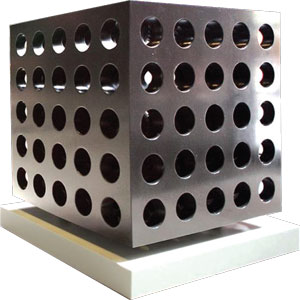
Jonathan Prince’s “Light Box” sculpture is currently on display at 590 Madison Ave.
When scoping out artwork, Daniel Brodsky is naturally inclined to buy paintings and drawings by architects, especially the Swiss-born modernist known as Le Corbusier. The Brodsky Organization senior partner is also the chairman of the Metropolitan Museum of Art, one of the most prestigious posts in the art world.
Daniel, 70, and his wife, art scholar Estrellita Brodsky, own about 500 pieces, mostly modern and contemporary art from Latin American artists such as Venezuelan Jesús Rafael Soto and Brazilian Lygia Clark.
The Brodskys “have never used a curator and have been fortunate to have had good relationships with living artists, many galleries and the auctions,” a spokesperson for the company said.
Brodsky became a trustee on the Met board in 2001 and was elected chairman in 2011.
The developer also has art and real estate in his blood.
Growing up, his mother was a painter and his father, Nathan Brodsky, was a developer. He and his father founded the Brodsky Organization in 1971. The firm owns 80 buildings with 8,000 apartments citywide, including its 19-story luxury condo at 135 East 79th Street that opened last year.
Francis Greenburger
Francis Greenburger, CEO of Time Equities, has been a collector of abstract and realist art since the 1980s. He told TRD in a 2007 interview that his priciest buy was a sculpture by Philip Grausman for $95,000.
It’s unclear whether he’s topped that with a pricier purchase. While he might not compete with the other New York City moguls mentioned here when it comes to collecting, his philanthropic work is noteworthy.
In 1986, he created the Francis J. Greenburger Award to recognize an unknown artist with a $12,500 prize every year. Then in the 1990s, he founded the Omi International Arts Center, an upstate New York-based nonprofit with residency programs for visual artists as well as writers and musicians on a 300-acre campus. The site, in Ghent, N.Y., houses a 60-acre sculpture park called the Fields, which the late art dealer André Emmerich helped Greenburger create.
“I had all this land at Omi,” Greenburger told the Financial Times. “I consulted André, who was a great champion of sculpture in the landscape. He said, ‘This is very timely as I’m closing my own sculpture garden. Come and choose what you want!’”
For his contributions to the arts, the French government recognized Greenburger in 2008 with its insignia of Chevalier of the Order of Arts and Letters.
Meanwhile, Time Equities’ Greenwich Village headquarters holds more than 200 pieces of art, from the likes of Kenneth Noland, Stephen Mueller and more.
The company, which is now developing the 64-story condo tower 50 West Street, employs an in-house curator to head its “Art in Buildings” program.
In 2009, Greenburger told the New York Times that he had considered dabbling in painting, but decided against it. “I thought about painting a little bit, but it seemed like it was pretty hard to do well,” he said.
